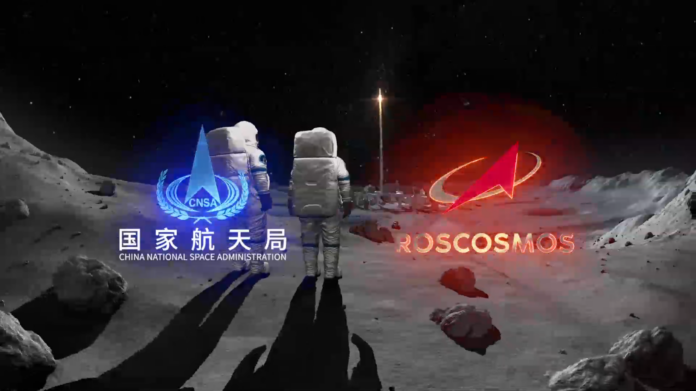The past decade or so has seen a major increase in interest to put humans back on the Moon. The most ambitious and flashy plans are mostly from western players such as SpaceX, but more recently, we have seen China and Russia increase and better-define their Lunar ambitions. In June 2021 at the Global Space Exploration Conference (GLEX), China and Russia jointly revealed a roadmap for a future International Lunar Research Station (ILRS) dedicated to scientific research.
China and Russia had already announced their intention of cooperation in March 2021, with a signature of a Memorandum of Understanding, though as we noted at the time, MoUs have pretty limited meaning in terms of being legally binding, or even representing a project that is in a well-developed stage. The more recent roadmap does, however, appear to be pretty well-defined, and the ILRS project seems to be picking up momentum. Although initiated by the CNSA and Roscosmos, the cooperation project is declared to be open to all interested international actors.
Interestingly, a video published by CNSA at the time of the ILRS announcement (in English) gave homage to previous missions such as Apollo-11, but also mentioned that, “this time, we come with greater courage, stronger determination, and more ambitious goals, and we are no longer satisfied with simple visits, we are here for the long-term exploration”. Indeed, it looks like China is planning to create a semi-permanent or permanent presence on the Moon in partnership with their Russian counterparts.
A 3-Step Project
The ILRS project will be carried out in three phases: 1) Reconnaissance, 2) Construction and 3) Utilization.
- The Reconnaissance phase is supposed to last from 2021 to 2025. Both China and Russia will send 3 spacecraft to the Moon: Chang’e-4, 6 and 7 for China, and LUNA-25, 26 and 27 for Russia. The objective will be to perform “technology verification for secure high-precision soft landing”, as well as to select a site for the future ILRS. As China and Russia collect more data during this phase, it will also feed into decisions being made about the design of the ILRS. The Reconnaissance phase will primarily involve collecting a lot of different data about the moon, including remote sensing data, in-situ data collection (i.e. landers/rovers collecting data on the surface), and sample returns. Small note that Chang’e-4, included in the Reconnaissance Phase, was actually launched in 2018, quite a bit before the phase began.
In between the Reconnaissance Phase and the Construction Phase appears to be a several year gap (basically 2026-2029). The video released by CNSA notes that from 2026-2030, Chang’e-8 and Luna-28 missions will be dispatched to the Moon to conduct corroborative explorations, finish technology verifications of the ILRS.
- The objectives of the Construction phase, which should last from 2030 to 2035, will be to establish the in-orbit and surface facilities of the ILRS for research, exploration, and verification of in-situ utilization of resources, as well as infrastructural facilities for energy, communication and transportation services. Other objectives include the performance of “technology verification for the command center of ILRS”, the organization of lunar sample return and of massive-cargo delivery, as well as the start of joint operations. Several missions are already planned, including the Chang’e-8 and LUNA-28 missions, as well as ILRS-1, 2, 3, 4 and 5.
The ILRS will include cislunar transportation facilities, long-term support facilities on lunar surface, lunar transportation and operation facilities, scientific facilities, as well as ground support and application facilities. - Lastly, the Utilization phase should begin in 2036, with the objective of lunar research and exploration, technology verification, resource utilization, as well as the performance of human missions to the completed ILRS.
The overall scientific objectives include research on and exploration of lunar topography, geomorphology and geological structure, lunar physics and internal structure, lunar chemistry, cislunar space environment, lunar-based astronomical observation, lunar-based Earth observation, lunar-based biological and medical experiment, as well as lunar resources in-situ utilization. The June roadmap also reveals cooperation opportunities for potential international partners.
A Competitor to Artemis?
It seems like the ILRS is increasingly looking like a full-fledged competitor to the US-led Artemis program, and it seems that participating countries are either in one project or another. We may see some exceptions:
- While Russia plays a leading role in ILRS, it might want to keep a minimal, but nonetheless non-zero effort in the Artemis program.
- Brazil, which recently signed the Artemis Accords and is aiming at taking an active role in the US-led program, also has had historically close ties in space with China (notably for the CBERS satellites), and may want to remain on both sides of the fence.
- Similarly, France’s CNES and Europe’s ESA, two historical partners of NASA, have also been quoted as being in discussion for the ILRS.
A significant amount of documentation was released on the ILRS during the GLEX conference, which is a good point considering that a lot of the previously known information on the ILRS was very early stage proposals and only coming from Chinese sources. Now we have documents that are co-authored by both Roscosmos and CNSA.
Overall, we are still a long way from seeing consistent and sustained human presence on the Moon. But with the recent announcements surrounding ILRS, we are at least one step closer, and have another player ready to take the lead on a human Lunar project.



